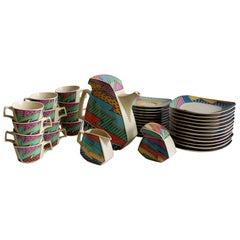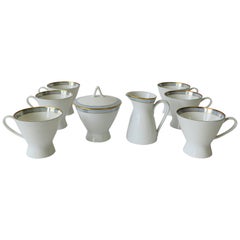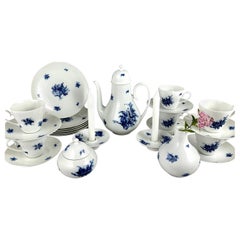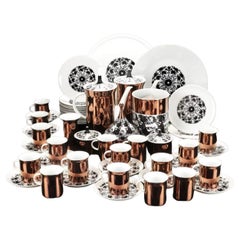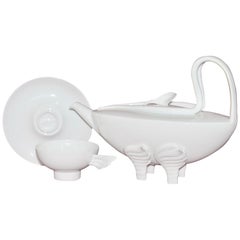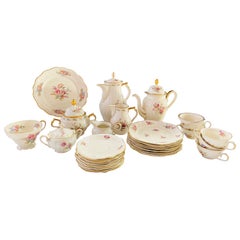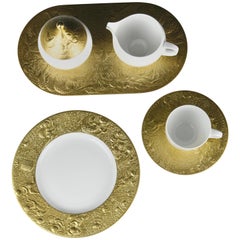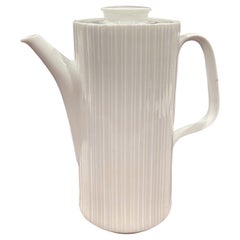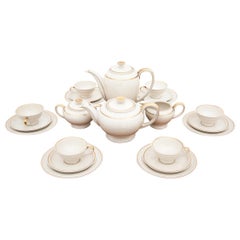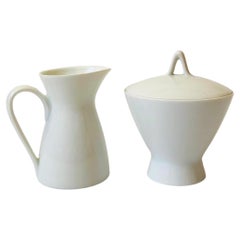Rosenthal Tea Sets
While the Rosenthal Porcelain Factory grew from humble decorating roots — as many pottery companies do — it eventually built a list of universally revered designer and artist partners that included Andy Warhol and Salvador Dalí. And after securing an enviable position as a top manufacturer of serveware and dominating the porcelain and bone china markets, Rosenthal expanded into furniture production, working with influential designers Verner Panton, Luigi Colani and Günther Ferdinand Ris and Herbert Selldorf.
German-born Jewish businessman Philipp Rosenthal founded the company in 1879 in Bavaria. It began as his modest workshop where he painted porcelain and encountered success with porcelain ashtrays. Rosenthal hired the best designers and clay modelers he could find. Adolf Oppel designed figurative Art Nouveau pieces, while Eleonore (Lore) Friedrich-Gronau produced decorative objects, namely her graceful porcelain dancer figurines, for the company.
Dinnerware, though, would be a Rosenthal mainstay. Between 1904 and 1910, Rosenthal produced its renowned dinnerware lines such as Donatello, Darmstadt and Isolde. These were introduced as unornamented white pieces — only later were they given their underglaze designs.
Rosenthal founder Philipp, a Catholic of Jewish ancestry, resigned in 1934 as the company’s president due to pressures owing to discriminatory German laws that took shape during the rise of the Nazi regime. Rosenthal died in 1937, and the family fled to America. The company would not regain its footing until 1950 when Rosenthal’s son, Philip, joined the firm and, in 1958, became chairman and dubbed Germany’s “China King.” At its peak, the company had 10,000 employees.
In the 1950s, Rosenthal’s modernist dinnerware was a significant part of the brand’s offerings, and by 1961 they introduced the famed Rosenthal Studio Line. Although furniture designers and ceramicists would lead the list of individuals working with Rosenthal — among them Tapio Wirkkala, Max Weber and Lisa Larson — the company eventually reached out to fine artists, not only Dalí and Warhol but Sandro Chia and Kenny Scharf. Rosenthal also collaborated with fashion designers Gianni Versace and Donatella Versace.
In a daring move in 1972, the company diversified into furniture, collaborating with some of the giants of mid-century modern design. The revolutionary Sunball chair, an icon of Space Age seating crafted by Selldorf and Ris, was among Rosenthal’s stellar successes in this venture.
On 1stDibs, find vintage Rosenthal ceramics, porcelain, tableware, seating and more.
Late 20th Century German Mid-Century Modern Rosenthal Tea Sets
Porcelain
Mid-20th Century German Mid-Century Modern Rosenthal Tea Sets
Porcelain
1960s German Vintage Rosenthal Tea Sets
Porcelain
1970s German Mid-Century Modern Vintage Rosenthal Tea Sets
Copper
20th Century Rosenthal Tea Sets
Porcelain
20th Century German Victorian Rosenthal Tea Sets
Porcelain
1960s German Mid-Century Modern Vintage Rosenthal Tea Sets
Porcelain
Mid-20th Century German Mid-Century Modern Rosenthal Tea Sets
Porcelain
1950s German Mid-Century Modern Vintage Rosenthal Tea Sets
Ceramic
Late 20th Century German Mid-Century Modern Rosenthal Tea Sets
Porcelain
1980s German Baroque Vintage Rosenthal Tea Sets
Porcelain
20th Century Rosenthal Tea Sets
Porcelain
1960s German Modern Vintage Rosenthal Tea Sets
Porcelain
1980s German Modern Vintage Rosenthal Tea Sets
Porcelain
1980s German Art Deco Vintage Rosenthal Tea Sets
Porcelain
20th Century German Mid-Century Modern Rosenthal Tea Sets
Porcelain
1950s German Mid-Century Modern Vintage Rosenthal Tea Sets
Porcelain
Late 20th Century German Post-Modern Rosenthal Tea Sets
Porcelain
Mid-20th Century German Rosenthal Tea Sets
Porcelain
1970s Finnish Vintage Rosenthal Tea Sets
Porcelain
1980s German Baroque Vintage Rosenthal Tea Sets
Porcelain
Mid-20th Century German Mid-Century Modern Rosenthal Tea Sets
Porcelain
Mid-20th Century French Restauration Rosenthal Tea Sets
Porcelain
1930s Czech Art Deco Vintage Rosenthal Tea Sets
Porcelain
1980s German Vintage Rosenthal Tea Sets
Porcelain
1950s German Mid-Century Modern Vintage Rosenthal Tea Sets
Ceramic
Late 20th Century Japonisme Rosenthal Tea Sets
Porcelain
1970s German Mid-Century Modern Vintage Rosenthal Tea Sets
Ceramic
2010s Italian Rosenthal Tea Sets
Porcelain
Early 20th Century Rosenthal Tea Sets
Porcelain
Mid-20th Century German Other Rosenthal Tea Sets
Porcelain
1970s German Modern Vintage Rosenthal Tea Sets
Porcelain, Wood
Mid-20th Century German Mid-Century Modern Rosenthal Tea Sets
Porcelain
Mid-20th Century German Mid-Century Modern Rosenthal Tea Sets
Porcelain
Early 2000s German Rosenthal Tea Sets
Porcelain
1960s German Bauhaus Vintage Rosenthal Tea Sets
Porcelain
1950s German Vintage Rosenthal Tea Sets
Porcelain
1950s German Mid-Century Modern Vintage Rosenthal Tea Sets
Porcelain
1960s German Post-Modern Vintage Rosenthal Tea Sets
Porcelain
1970s German Space Age Vintage Rosenthal Tea Sets
Porcelain
Late 20th Century German Modern Rosenthal Tea Sets
Porcelain
1950s German Mid-Century Modern Vintage Rosenthal Tea Sets
Ceramic
1950s German Mid-Century Modern Vintage Rosenthal Tea Sets
Ceramic
1980s German Post-Modern Vintage Rosenthal Tea Sets
Porcelain
Rosenthal tea sets for sale on 1stDibs.
- 1stDibs ExpertNovember 5, 2024To identify an antique tea set, look closely to determine who the manufacturer is. Locate the hallmark on the bottom of a saucer, teapot or cup. A maker’s mark on one of these items is the best indicator of the set’s origin. If you snap a photo with your smartphone or tablet, you can conduct a reverse image search to jump-start your research. Professionals recommend consulting auction catalogs, books and trusted online resources such as museum exhibition materials. With some research, you may be able to match the marking to the manufacturer's name and, from there, identify the pattern and age.
In 17th-century England, Chinese tea began to arrive at ports in London. Mass production of porcelain tea sets took place in the 18th century, and during the early 1800s, tea became widely affordable, and the concept of teatime took shape all over England.
Reputable soft-paste porcelain makers include Sèvres, Capodimonte and Chelsea, while Meissen was the first European maker of hard-paste porcelain. Bone china manufactories of note include Spode, Minton and Derby, which was later called the Royal Crown Derby Porcelain Company.
Generally, a tea set is considered vintage if it’s at least 20 years old, while antiques are at least 100 years old. Although a maker’s mark is generally a helpful indicator of a given manufacturer, forgeries have occurred over the years. Look for other signifiers of a material, time period or style if you are uncertain of your piece’s origin. For help with identification, seek out a certified appraiser or knowledgeable antique dealer.
Find antique tea sets on 1stDibs. - 1stDibs ExpertApril 5, 2022To identify Rosenthal crystal, look for one of the company's maker's marks. The German crystal manufacturer changed their hallmark many times over the years, so you can use an authoritative online reference to determine an approximate manufacturing date. On 1stDibs, find a selection of expertly vetted Rosenthal crystal.
- 1stDibs ExpertMarch 22, 2022Rosenthal porcelain is made in factories in Selb and Speichersdorf, Germany. Notably, the head of the Bauhaus school, Walter Gropius, designed the factory in Selb. Philipp Rosenthal founded Rosenthal in 1879. On 1stDibs, you can find a selection of Rosenthal porcelain.
- Who owns Rosenthal china?1 Answer1stDibs ExpertApril 5, 2022Sambonet Paderno Industrie S.p.A. owns Rosenthal china as of January 2022. The Italian company purchased the porcelain manufacturer in 2009. Philipp Rosenthal founded Rosenthal in 1879 in Selb, Bavaria, Germany. You'll find a variety of Rosenthal china on 1stDibs.
- 1stDibs ExpertApril 5, 2022Yes, Rosenthal china is still being produced. Rosenthal was founded in 1979 in Germany with a passion for innovation and design with high-quality materials and hand-painted designs. Shop a collection of authentic Rosenthal goods on 1stDibs.
